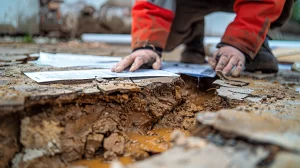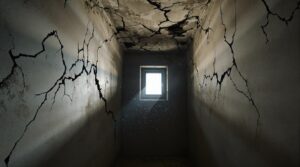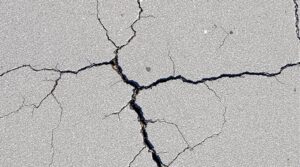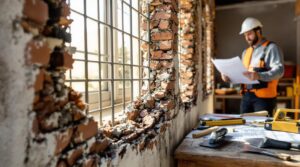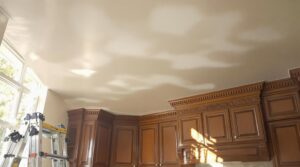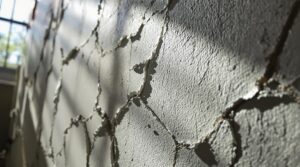Home insurance coverage for cracked walls varies based on the cause and policy terms. Standard policies typically cover sudden, accidental damage from specific perils like fires, fallen trees, or lightning strikes. However, damage from normal wear, settling, or gradual deterioration is usually excluded. Cracks wider than 0.25 inches may indicate serious foundation issues requiring professional evaluation. Understanding the distinctions between covered and non-covered causes helps homeowners navigate their insurance protection effectively.
Key Takeaways
- Home insurance typically covers wall cracks caused by sudden, covered perils like fires, fallen trees, or lightning strikes.
- Normal wear and tear, natural settling, and gradual deterioration of walls are generally excluded from standard insurance coverage.
- Cracks wider than 0.25 inches may indicate serious structural damage and require professional assessment during claims.
- Documentation with photos, videos, and contractor estimates is essential when filing a wall damage insurance claim.
- Insurance coverage depends on the specific cause of wall damage and whether it resulted from a peril named in your policy.
Understanding Insurance Coverage for Wall Damage
When homeowners discover cracked walls in their properties, insurance coverage becomes a vital consideration that requires careful examination of policy terms.
Standard homeowners insurance policy provisions typically exclude normal wear and tear, including structural deterioration that occurs gradually over time.
Insurance covers wall damage only when it results from specific covered perils, such as fire damage, wind impact, or falling objects.
To successfully file an insurance claim, property owners must assess the damage thoroughly and determine its underlying cause.
The width of cracks serves as a vital indicator, with those exceeding 0.25 inches potentially signifying serious foundation damage that warrants immediate attention.
However, cracks under 0.125 inches generally represent minimal structural concern.
Policy coverage limitations often exclude damage from natural settling, making it essential for homeowners to understand their specific policy terms regarding wall and foundation issues.
A detailed review of coverage parameters helps determine whether repair costs qualify for insurance reimbursement.
Like other maintenance-related issues, wall cracks resulting from poor upkeep or normal aging are typically not covered by standard homeowners insurance policies.
Types of Cracks Typically Covered by Home Insurance
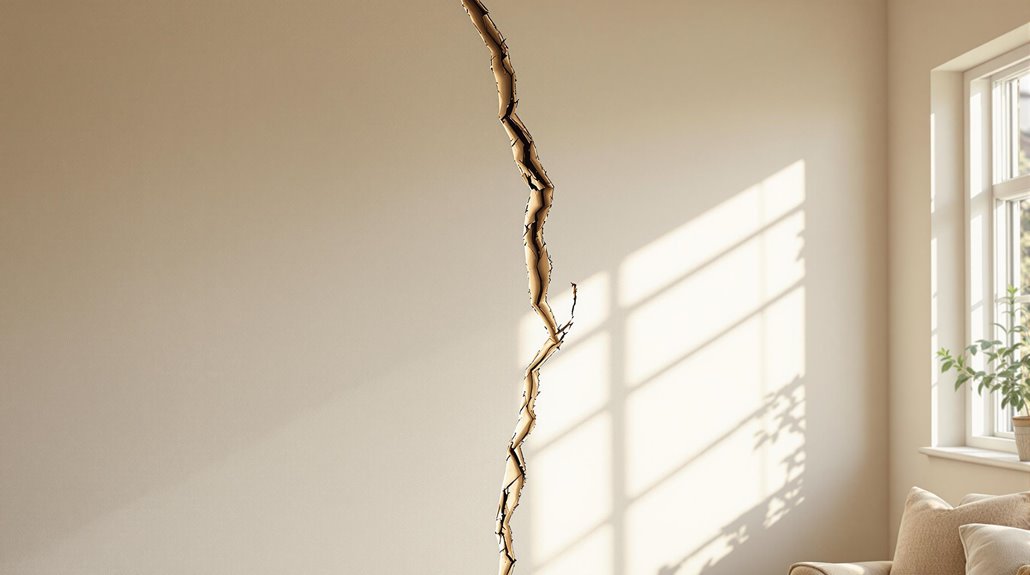
Although homeowners insurance policies vary by provider, they generally cover wall cracks caused by sudden, accidental events specified as named perils in the policy documentation. These covered incidents typically include damage from fires, lightning strikes, and fallen trees that directly impact the structural integrity of walls.
Insurance providers distinguish between covered wall damage and excluded conditions. While normal wear and tear and foundation damage from settling are typically excluded from coverage, significant structural issues resulting from covered perils warrant attention. Cracks exceeding .25 inches may indicate serious underlying problems that require professional evaluation during the claims process.
To successfully file claims for cracked walls, homeowners must provide thorough documentation establishing that the damage resulted from a named peril rather than gradual deterioration or inadequate maintenance.
Insurance adjusters evaluate each case based on the specific circumstances and policy terms to determine coverage eligibility. Working with a public adjuster can help homeowners better understand their policy coverage and maximize compensation for wall damage claims.
Steps to File a Wall Damage Insurance Claim

Filing a successful wall damage insurance claim requires following a systematic process to guarantee proper documentation and evaluation. The first step involves promptly contacting the insurance company upon discovering damage that may be covered by homeowners insurance.
Documentation is critical: homeowners must thoroughly photograph or video record the damage, noting the extent and precise location of all cracks or structural issues.
The process continues with completing all required claims forms provided by the policy issuer, ensuring accuracy in every detail. Subsequently, an insurance adjuster will conduct an on-site assessment to evaluate whether the damage is covered by homeowners insurance.
During this phase, maintaining organized records of contractor estimates and potential foundation repair costs is essential. These supporting documents help determine if the claim for foundation damage meets the coverage criteria specified in the homeowners policy and assists in calculating appropriate compensation amounts.
For complex structural damage claims, hiring a public insurance adjuster can help maximize settlement amounts through expert negotiation and claim evaluation.
Warning Signs of Serious Wall Cracks
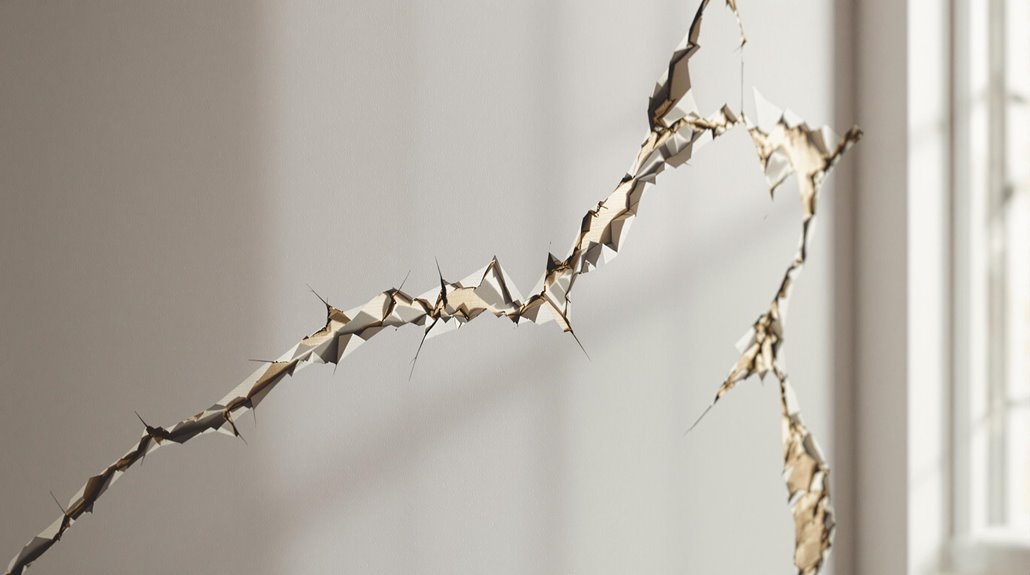
Identifying serious wall cracks requires homeowners to understand key warning signs that distinguish minor cosmetic issues from potentially hazardous structural damage.
Foundation cracks larger than 0.25 inches in width demand immediate professional assessment, as they often indicate serious structural issues that could compromise the building's integrity.
Homeowners should pay particular attention to the characteristics and location of wall damage. Jagged cracks or those appearing along seam lines may signal foundation movement, while horizontal cracks typically indicate concerning pressure from the foundation.
Though vertical cracks sometimes result from normal settling, their progression should be monitored. Cracks near windows and door frames are especially critical, as they can reveal foundation shifting that affects structural stability.
To prevent escalation of damage, property owners should implement systematic monitoring of crack patterns, documenting size changes and locations to facilitate timely repairs when warning signs emerge.
Prevention and Maintenance Tips for Wall Protection
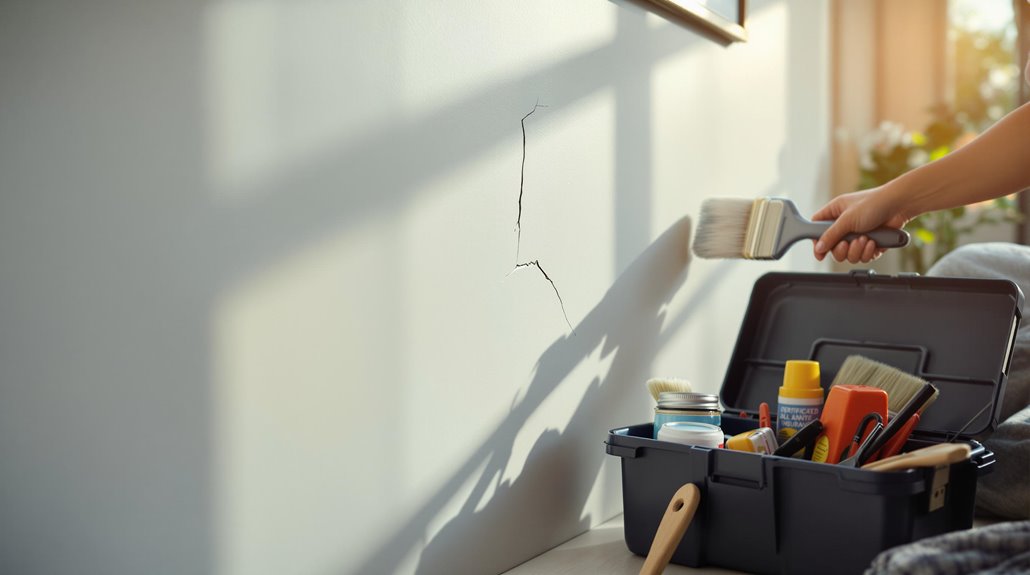
To maintain structural integrity and prevent wall damage, homeowners must implement a thorough maintenance strategy that addresses potential causes of wall deterioration.
Regular inspection of walls for cracks exceeding 0.25 inches helps identify structural issues before they escalate into severe problems requiring costly repairs.
Effective water management plays an essential role in preventing foundation and wall damage. Proper drainage systems, including well-maintained gutters and downspouts, prevent water accumulation around the foundation.
Homeowners should verify these systems remain free from clogs and direct water away from the building's perimeter. Strategic landscaping with appropriate slopes directing water away from the structure further enhances protection against moisture-related issues.
Moisture control extends beyond exterior maintenance. Indoor humidity levels must be monitored and regulated to prevent wall deterioration.
Working with public adjusters can increase insurance claim settlements by up to 50% when significant wall damage occurs.
Implementing these maintenance tips can greatly reduce the risk of water damage and crack formation, ultimately preserving the structural integrity of the home's walls and foundation.
Frequently Asked Questions
Are Cracks in Walls Covered by Homeowners Insurance?
Homeowners insurance typically excludes wall cracks from normal wear or foundation issues, but may cover them if caused by specific covered perils. Coverage limits and policy exclusions vary among insurance policies.
Does Home Insurance Cover Wall Damage?
By telegraph, homeowners insurance covers walls damage from sudden, covered perils but excludes maintenance issues. Coverage limits apply to structural integrity repairs, while policy exclusions restrict claims for foundation issues and typical deterioration.
Does a Home Warranty Cover Wall Cracks?
Home warranties typically exclude wall cracks and structural damage from coverage. These maintenance issues fall outside standard warranty benefits, requiring homeowners to seek alternative solutions or insurance policies for wall repair costs.
What Is the 80% Rule in Homeowners Insurance?
The 80% rule requires homeowners to insure their property for at least 80% of replacement cost to receive full coverage during claims. Underinsuring below this threshold results in reduced claim payouts.
Final Thoughts
Wall cracks, like spider webs creeping across plaster, represent potential threats to structural integrity that demand immediate attention. Insurance coverage hinges on precise documentation of causation, with sudden, accidental damage typically covered while gradual deterioration remains excluded. Homeowners must maintain vigilant monitoring, implement preventive measures, and understand their policy's specific parameters to effectively protect their investment against both covered and non-covered wall damage scenarios.
When dealing with wall cracks or any property damage claims under a homeowners insurance policy, insurance industry experts and legal professionals strongly recommend consulting a qualified state-licensed public adjuster. These professionals work exclusively for policyholders, not insurance companies, serving as dedicated advocates throughout the claims process. Public adjusters are state-licensed experts who help homeowners navigate complex insurance policies, identify hidden damages often unknown to policyholders, thoroughly document losses, and negotiate with insurance companies to secure fair settlements while protecting policyholder rights.
Engaging a public adjuster can provide significant advantages, including maximized claim settlements, expedited processing, and reduced stress during the claims process, allowing homeowners to focus on recovery. For those seeking expert guidance with property damage or loss claims, a no-obligation free consultation is available through a Public Claims Adjusters Network (PCAN) member public adjuster via their contact page.

